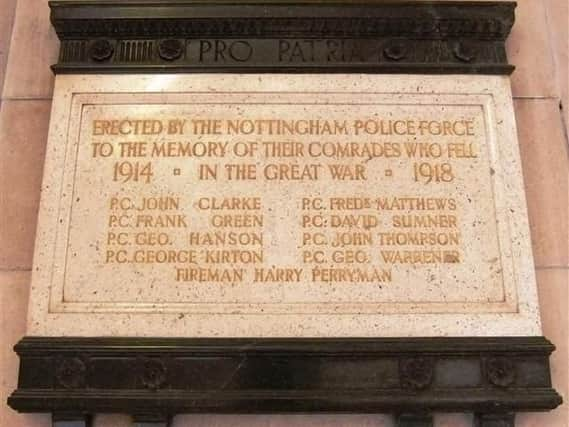Nottinghamshire Police pay respects to fallen officers on Armistice Day


The Nottingham Police Force memorial is located in Byron House on Maid Marian Way and remembers eight constables and one fireman who gave their lives.
Corporal John Clarke lived in Sneinton and worked as a PC with B Division from 1904 until he enlisted with the Royal Munster Fusiliers in 1915.
Advertisement
Hide AdAdvertisement
Hide AdHe died of his wounds in France on 12 September 1916 and is buried in Heilly Station Cemetery.
Corporal Clarke was 39 years old when he died, leaving behind his wife, Rose.
Sapper Frank Green may have lived in Beaconsfield Street before he enlisted with the Royal Engineers.
He died at Salonika on 4 October 1916, aged 23, and is buried in Struma Military Cemetery.
Advertisement
Hide AdAdvertisement
Hide AdHe left behind his mother, Thirza Ann, and three siblings, Thirza, Fred and Edgar.
Company Sergeant Major George Frederick William Hanson was born in Beeston.
He joined Nottingham Police Force in 1909 and served as PC 57 with A Division.
He enlisted with the Duke of Cornwall’s Light Infantry but died of his wounds, as well as pneumonia, in Boulogne on 25 April 1917. Co
Advertisement
Hide AdAdvertisement
Hide AdCompany Sergeant Major Hanson is buried in Boulogne Eastern Cemetery and was 32 years old when he died, leaving behind his wife, Edith Annie, and his seven-year-old son, George, as well as his parents, George Willoughby and Annie Elizabeth, and six siblings, John Joseph, Arthur Edwin, Elizabeth Nellie, Emma Lillian, Annie Florence and Ada Gertrude.
Private George Kerton served as PC 287 with A Division from 1908, before enlisting with the Grenadier Guards.
He fought in the Third Battle of Ypres but was killed in fighting on 12 October 1917, aged 37.
He left behind his wife, Anastasia, and his young daughter Edna Catherine, as well as his parents, Walter and Grace, and sisters, Emily, Katherine, Elizabeth and Edith.
He is buried in Dozinghem Military Cemetery.
Private Frederick Richard Matthews lived in Hyson Green.
Advertisement
Hide AdAdvertisement
Hide AdHe enlisted with the Army Service Corps in October 1915 and was sent to Boulogne in 1917, where he joined the Duke of Wellington’s (West Riding Regiment) on 5 October 1917.
He fought at the First Battle of Passchendaele and was declared missing, presumed dead, on 10 October 1917, aged 34.
He is remembered on the Tyne Cot Memorial and left behind his wife, Mable, and their two daughters, eight-year-old Elizabeth Irene and six-year-old Doris Ada, as well as his parents, Thompson and Elizabeth.
Private Henry Perryman served as a police fireman with the City Fire Brigade from 1911.
Advertisement
Hide AdAdvertisement
Hide AdHe lived with another police fireman, Frank Pitchfork, before enlisting with the Sherwood Foresters (Notts & Derby Regiment) in 1914. He landed in France in February 1915 but died from his wounds later that year on 5 October.
Private Perryman wrote to the Nottingham Post in 1915 to describe his experience, saying: “Just a few lines to let the Nottingham people know how the Robin Hoods fared in their first experience of being in the trenches under fire. We left Bocking, Essex, on February 25th, and arrived France on the 28th. At some places we were only 80 yards from the German lines. It was quite exciting, the English, French and German guns going all day and night long. It reminds one of a fireworks display, especially when the rockets go up every now and then to find out the different positions at night time...We are enjoying ourselves as well as we can, and our officers do everything in their power to make us as comfortable as possible…You can take it from a good source that the Robin Hoods will make a name for themselves before they come back to England.”
Private Perryman was 32 years old when he died, leaving behind his wife, Mary Ellen, and their children, three-year-old Sydney and two-year-old Barbara. He also left behind his father, William John, and siblings Alice and Jeremiah. An article in the Nottingham Evening Post announced his death, saying he was “of a singularly happy disposition, he was extremely popular alike with his officers and colleagues, and when he came home for a few days’ leave some three months ago entertained them with some characteristically humorous anecdotes…The news of his death has been received with great regret.”
Private David Henry Sumner enlisted with the King’s Own Yorkshire Light Infantry in 1914. He was killed on 28 October 1914, aged 25, and was posthumously awarded the 1914 Star. He left behind his parents, John Henry and Mary, brother, William, and sister, Lucy.
Advertisement
Hide AdAdvertisement
Hide AdCompany Quartermaster Sergeant John Thompson lived in Forest Fields and was a PC with Nottingham Police Force from 1911. He joined the Sherwood Foresters (Notts & Derby Regiment) but was killed in action at Ypres on 30 July 1917, aged 34. He is remembered on the Ypres (Menin Gate) Memorial and left behind his wife, Julia, daughter, Nellie Chrissie and parents, Thomas and Sarah.
Private George Henry Warrener lived in The Meadows and was a PC with Nottingham Police Force from 1911. He joined the Grenadier Guards and landed in France in 1914. He was killed in action on 25 September 1916, aged 28, and buried in the Guards’ Cemetery at Lesboeufs. He left behind his mother, Harriet, sisters, Annie Elizabeth, Nellie, Florence and Winnie and brothers, Harry and William Arthur.